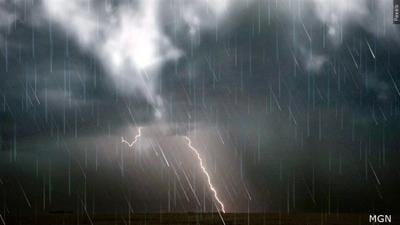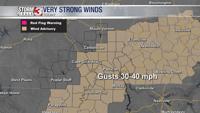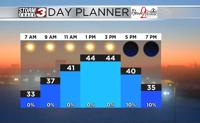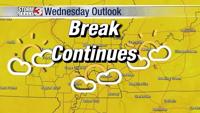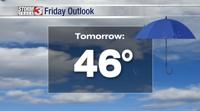PADUCAH, Ky. -- Anytime there are storms in the forecast, it's better to prepare in case something were to happen.
A number of potential threats come with a storm, including high winds, flooding, lightning and more.
According to the National Weather Service (NWS), here are some safety tips you need to know before, during and after a storm...
Tornado Safety
Before a Tornado
- Make sure all family members know the tornado safe location in your home
- Store an emergency kit in your safe location
- Identify where to go if you are at work or school
- Make a family communications plan
During a Tornado
- Go to a safe location away from windows on the lowest level of a sturdy building
- If you are caught outside, get in a car, buckle up and try to drive to the closest sturdy shelter
- Never seek shelter under a bridge and only lie flat in a ditch as a last resort
- Go to a secure storm shelter if you are in a mobile home
Preparing your pets
- Get your pets ready at the first sign of an approaching storm
- Put your dog on a leash and your cat in a carrier
- Move all pets to the shelter well ahead of the storm
- Include pet food and medicines in your emergency kit
After a Tornado
- Beware of downed power lines, broken gas lines and sharp/dangerous objects
- Avoid damaged area
- Stay off the roads to allow rescue workers clear passage
- Follow instructions from local officials
Flood Safety
- Never drive through flood waters
- Never drive around barricades
- Most flood fatalities occur in vehicles
- 12 inches of water can sweep a car off the road
- Driving into floodwaters also puts rescuers' lives at risk
- Turn around, don't drown
- Never walk into floodwaters
- It only takes six inches of moving water to knock an adult off his or her feet
Lightning Safety
If you're caught outside in a storm
- Avoid open fields, the top of a hill or a ridge top
- Stay away from tall, isolated trees or other tall objects
- Stay away from water, wet items and metal objects
- *A tent or open air building like a picnic shelter will not protect you from lightning
When you're inside a car during a storm
- Close all windows
- Don't touch metal objects
- Pull over on the side of the road and turn on your hazard lights
When you're inside during a thunderstorm
- Don't tough electrical equipment or electronics plugged into the wall
- Stay off corded phones and avoid plumbing
- Stay away from windows and doors, and stay off porches
- Do not lie on concrete floors or lean against concrete walls
Hurricane Safety
While we won't feel the initial strongest impacts from a hurricane in southern Illinois, southeast Missouri and western Kentucky, it's not uncommon to get hit by remnants of powerful hurricanes which reach far inland.
A lot of impactful weather can reach far inland from hurricanes which can pose a risk for severe storms, lightning, flash floods and more. Here are some general impacts from hurricanes, mainly for coastal communities.
- Storm surge is the abnormal rise of water generated by a storm's winds. This hazard is historically the leading cause of hurricane related deaths in the United States. Storm surge and large battering waves can result in large loss of life and cause massive destruction along the coast.
- Storm surge can travel several miles inland, especially along bays, rivers, and estuaries.
- Flooding from heavy rains is the second leading cause of fatalities from landfalling tropical cyclones. Widespread torrential rains associated with these storms often cause flooding hundreds of miles inland. This flooding can persist for several days after a storm has dissipated.
- Winds from a hurricane can destroy buildings and manufactured homes. Signs, roofing material, and other items left outside can become flying missiles during hurricanes.
- Tornadoes can accompany landfalling tropical cyclones. These tornadoes typically occur in rain bands well away from the center of the storm.
- Dangerous waves produced by a tropical cyclone's strong winds can pose a significant hazard to coastal residents and mariners. These waves can cause deadly rip currents, significant beach erosion, and damage to structures along the coastline, even when the storm is more than a 1,000 miles offshore.
Preparedness Saves Lives
According to the National Weather Service, there is nothing we can do to stop severe thunderstorms, lightning, tornadoes or floods from developing. However, there are things that everyone can do to minimize the impacts of severe weather on our lives.
What you can do to be prepared
Stay Informed
- This can be done by monitoring a weather alert radio, local radio & TV broadcasts, NWS web pages, or various applications on computers and smart phones.
- Don't just rely on one method - especially storm sirens - which are NOT designed to be heard indoors by everyone.Â
Have an emergency plan
- Do this for your home, business, schools and when you are traveling. Designate places to go to seek safe shelter from a tornado or severe thunderstorm. Pick two places to meet in case you are separated from your family or co-workers.
- While traveling or when away from home, know the names of the locations you are visiting - especially county and city names.
Prepare Yourself & Your Home For An Emergency
- Learn how to use a fire extinguisher, how to administer CPR, and how to turn off the electricity, gas and water supplies in your home.
- Inspect your home for potential hazards such as weakened trees or limbs, cracked windows or worn roofing.
- When you build a new structure - or renovate an existing one - there are ways to prevent wind damage to roofs, upper floors and garages. Rafters, trusses, walls and doors can all be reinforced.
Have an Emergency Supply Kit
Some storms produce power outages that will last for several days. Having the following items will help you cope with the disaster:
- Bottled water
- Non-perishable food
- Flashlights & extra batteries
- Extra clothing & blankets
- An extra set of keys & cash
- Medications & a first aid kit
- Personal hygiene items
- Pet supplies
- A weather alert radio or portable AM/FM radio
For more safety information, you can find that .

